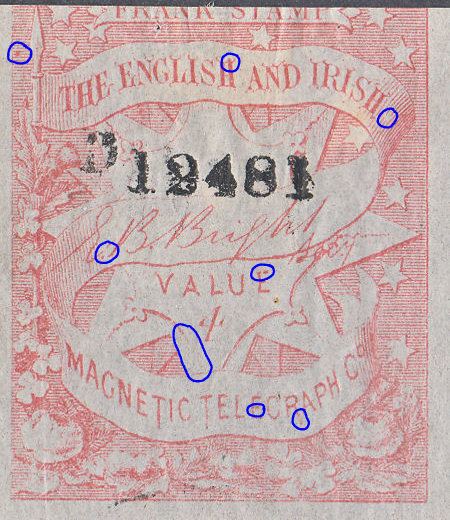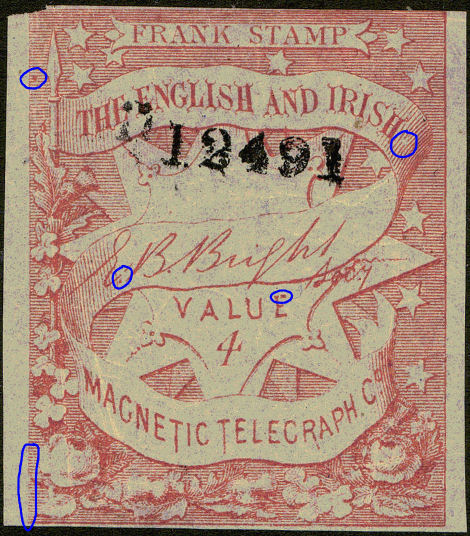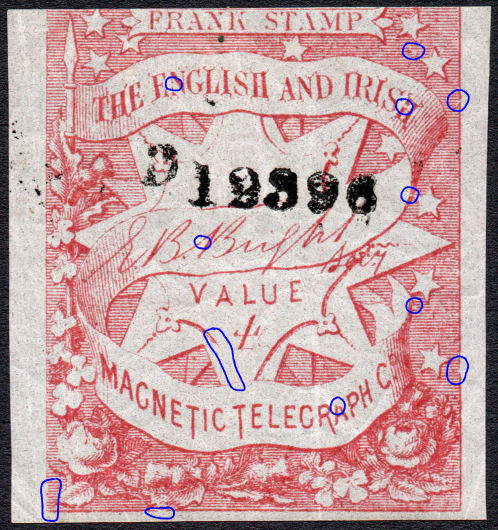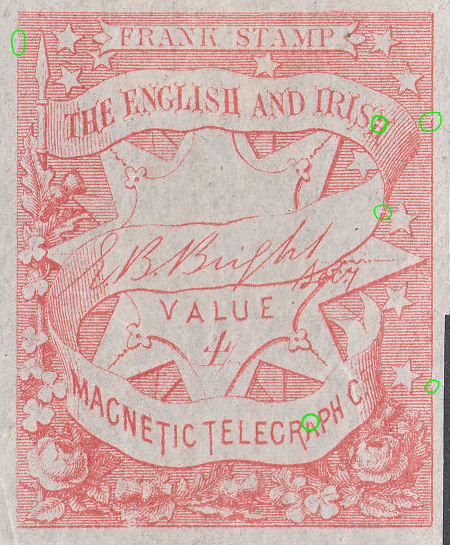| Shortcuts to different sections | ||||||
| Concepts | Group 1 | EIM Home | Evidence | Research | Plating-Group-2 | Plating-Group-3 |
The different face values fall into three groups.
| The first group, the 4/- value is the only one known without a letter before the control number and produced the most stamps by far. Morley said there were only 50 types of the 4/- value, and did not list tête-bêche pairs for it. |
| The second group was started with the 1/- value. A pane of 50 copies of the stamp in five rows of ten was prepared, to which was then added the '1/-' value individually. A plate of 100 stamps was made with two copies of this pane arranged tête-bêche to each other. The remainder blocks of 4 and tête-bêche pairs make this clear. To produce the 2/6d and 5/- values, a copy of this pane had the '1/-' removed from each stamp and replaced with the new value. This has left parts of the base of the '1' on some of them. The newly inscribe values are distinguishable between the two panes. Compare C02183 with C04163 (both row 1, column 3), and compare G01625 with G01675 (both row 3, column 5). This agrees with Morley if you ignore all differences due to transfer flaws. |
| The third group is just the '1/6' value. It has fewer flaws and more uniformly inscribed values, usually difficult to distinguish. Morley says there were 100 types. |
At some stage it was decided to add control letters. The first group ( 4/- ) started without any letter, if lettering started with the advent of the 1/- value,
then a decision must have been made at that stage as to how many letters to allocate between these two values.
Did they allocate 'B' for the 1/6 but decide not to then produce the plate with the rest of group 2, or (more likely),
the 1/6 was made individually after the 1/- value and the other two values were produced later from the 1/- value to save time
(or because the original die was not available ?).
It is possible that other values exist without lettering.
I started with the assumption that the sheets, or at least panes, were numbered sequentially from top-left to bottom-right, then cut into strips.
However my analysis of the numbers on stamps having the same flaws forces me to abandon this assumption.
Whilst each strips appears to be consistently numbered in sequence, the strips themselves are not consistently numbered according to the row within the pane.
I am now assuming that at least some of the sheets were cut into strips before being numbered.
This applies to all values.
Though I cannot rely on the control numbers to indicate the row of a stamp and there are no vertical pairs with stamps having control numbers,
there are remainders that can help.
There are tête-bêche pairs of 1/- stamps and blocks of 1/- and 1/6 stamps.
In addition there are remainders with wide margins at top or bottom to show they are from the top or bottom of a sheet, or at least a pane.
I will letter the rows rather than numbering them to avoid confusion, adding pane number when known.
If the second pane was made from the first then the second would have more flaws.
However it is more likely that a plate was made with two applications of a stone with 50 impressions.
In this case, for the 1/- value the pane numberings will be arbitrary, but can at least be consistent. for the other values, a second pane may simply start row 6 of the sheet.
There may alternatively have been a gap for guillotining.
Vertical pairs/blocks of remainders, together with strips of stamps with control numbers will help maintain consistency.
Here is a break-down of Group 1. (4/-) scans by quantities and column.
| Column | 1 | 2 | 3 | 4 | 5 | 6 | 7 | 8 | 9 | 0 | Total |
|---|---|---|---|---|---|---|---|---|---|---|---|
| Qty | 3 | 0 | 1 | 2 | 4 | 3 | 2 | 2 | 5 | 3 | 24 |
Though I have 4 images in column 5, strangely 3 of them have extremely similar flaws !
Here is a new image that should help, the first four are a reconstruction courtesy of Steve Lawrie, the last (courtesy of capital-collectables) I have added digitally.
There are very few examples to work with, and this should help a lot. Plating is unlikely to get far without substantial blocks of remainders.
At the moment I have 24 useful scans of different remainders and 24 with serial numbers. With the 1/-, 2/6d and especially with the 5/-, it is easy to see
that there were two different panes because of differences in the figures of the values. The figure '4' on these is remarkably consistent, though what
follows it can vary. At the moment I am inclined to think that either there was only one pane, or a second pane was copied from the first.
I really need more images though.
D12481 does appear to be a match for D12491 however.


The figure '4' also looks very similar. Morley says that only the 1/- and 4/- were printed with only 50 different types.
He also only lists the 1/- as having tête-bêche pairs, that leaves it open to question as to whether the 4/- sheets had one, or two panes of 50.
I cannot easily prove that he was right, but I can attempt to disprove him. The above pair do not disprove him.
Neither do these 2 below:


Again matching flaws and '4/-'.
Another example of a serialised stamp matching a remainder.
I now have 3 remainders very similar to D12474, the way the value is written looks very similar though.
There are differences, but every example of these may have imperfections.
Two remainders from the top of a pane:
I have three other examples of matching pairs of remainders.
This pair demonstrates that even poor examples can provide useful information.
I now know that there was at least 2 panes on the sheet (probably not more than 2). D12373 and 3 remainders split into two groups.
Comparing D12474 with the remainders at 4C also suggests that there were probably 2 panes of 50, but with the values written the same way in the two panes.
It is possible that the differences are different states due to wear or repair, I will put what seems to be the later state at the bottom. I would expect remainders to be late.
The 4/- value was used for longer than the others. It is possible that a fresh stone was prepared at some point.
A possible, though statistically unlikely arrangement of the 4/- value.
For what it's worth, this is 30% complete.
| D12373 Rem-6. |
D12379 | ||||||||
|---|---|---|---|---|---|---|---|---|---|
| D12411 | D12420 D12440 |
||||||||
| D12474 Rem-7 |
|||||||||
| D12481 D12491 |
D12485 Rem-10. |
D12466 Rem-15 |
D12467 |
D12468 |
D12469 | D12470 | |||
| D12415 | D12396 Rem-13. |
D12397 |
| Rem-1. Rem-2. |
Rem-12. | D12388 | D12389 | ||||||
|---|---|---|---|---|---|---|---|---|---|
| D12424 | 40889 | Rem-5. | |||||||
| Rem-8. Rem-14. |
Rem-3. Rem-11. |
||||||||
| D12486 | D12489 | ||||||||
| D12445 D12455 |
Rem-4 Rem-9 |
D12459 | Rem-0E. |
I have colour-coded stamps on the same strip. Some strips may overlap.
It is at least a starting point, giving something to build on.
Ignoring the used example, 40889, all of these are from only two sheets. That makes for a fairly high probability that new finds will belong to a new position.
D12389 looks the same as D12379 as far as the marked flaws and value are concerned, but I have put them on opposite panes for now since there is only
a 1 in 3 chance of them being from the same pane even if strips from the two sheets were mixed together before numbering.
One of these items (D12389) is of a stamp that can be seen here - BT Archive.
Further scans invited.
Last updated 8th. October 2023
©Copyright Steve Panting 2012/13/14/15/16/17/18/19/20/21/22/23 except where stated.
Permission is hereby granted to copy material for which the copyright is owned by myself, on condition that any data is not altered and this website is given credit.